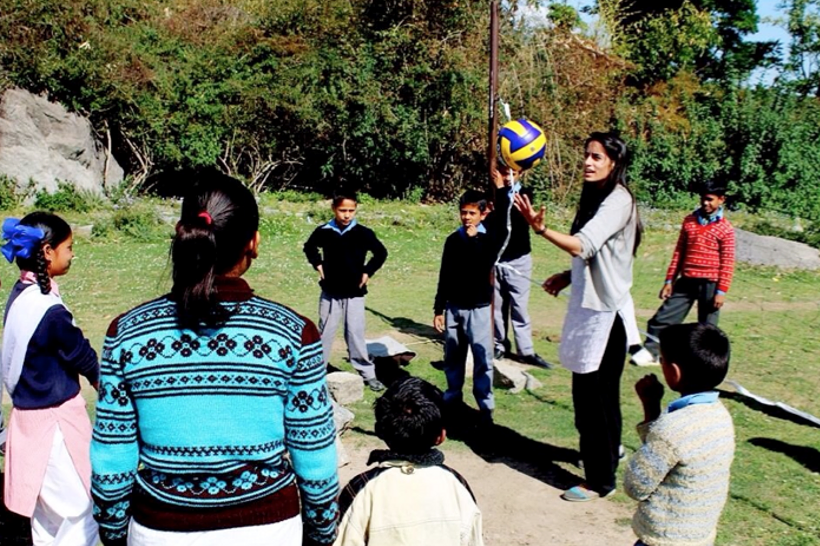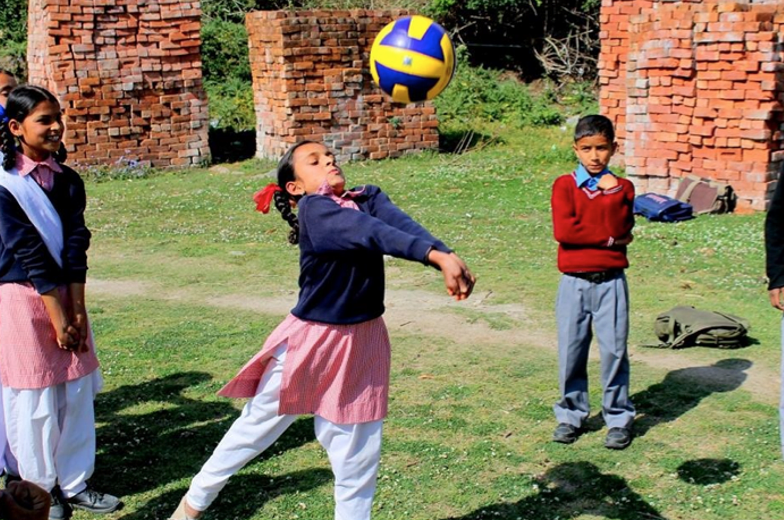Building a Community Through Sports
By Kiran Puri ‘13, Jagori Grameen (2013-2015)
The months leading up to the monsoon in Himachal can be brutal. The air becomes dry, while the sun beats down on the village mercilessly, scorching everything in its path. Everyone tries his or her best to stay indoors, or take refuge under a large leafy tree. Yet, here I was, standing between the earth and the sun being enveloped by the heat and loving every second of it. What could be the cause of this? I was dancing around on the semi-green grass, trying to teach 10 middle school kids how to play volleyball.
___
In my first couple months as a Shansi fellow at Jagori Grameen in India, I missed little from my life in the states. The food was great, the people were warm and caring, and work was exciting. But there was something missing. Something that had been a part of my identity for over 10 years, and had suddenly been cut out: sports. From volleyball, to basketball, to field hockey, athletics had always been a big part of my life. And now, it was gone and it didn’t feel right. I decided to try to find a way to not only play sports, but a way to coach young boys and girls. In October I started to volunteer at Nishtha, a local health clinic and community center. I went on field visits twice a week to villages and helped set up the outreach clinic ran by the Doctors there. As I got to know the clinic’s founder. Dr. Barbara, on a more personal level, I confided in her my love of sports and my interest in volleyball, as it was a non-contact sport that I believed boys and girls could play together, with out the boys dominated the play. To give some more background information, the health clinic was a community center where local children would come to for one hour after school. There was a small library, board games, and athletic equipment. While staff was on hand, they were mostly there to hand out equipment and manage the center, and didn’t have the most time to engage with the children. So when I expressed my interest, Dr. Barbara was excited because there would be someone to play with and engage the kids in athletics.
And so began the first phase of the project: Getting equipment! There were already volleyball polls put up by Nishtha a while ago, but no one had been there to coach the kids so they had gone largely unused. Since we had a place to play, we just needed to go out and get a net and a ball, which were relatively inexpensive. The first day I went out to net up the net and play volleyball, I was swarmed by a groups of young boys all about half my height. The girls would stand back in a groups, whispering amongst themselves and staring at what was going on, but reluctant to come play. Luckily I had the help of Suman, a woman who worked and lived in the area, and had a son that went to the same school as many of the kids. She was able to introduce me to girls, and with much difficulty, convince them to come and spend some time playing with us. I told off the other boys, but they didn’t seem to listen, they were so excited that they might get a chance to play volleyball.
I had the girls form a line and throw the ball the ball to them and have them try to bump the ball over the net. The young boys kept on pushing their way into the line, and the girls put up little to no resistance. While I was a little taken aback by the passive nature of the girls, I could understand as well. I remember being a young girl, unsure of myself and not knowing what to do with my rapidly growing limbs. And this domination of boys in athletics spaces is not something that is unique to this part of the world. While most schools in the west have male and female counterparts for school-associated athletics programs, the athletics scene is different outside of school. If you walk by a park or court in the evening, there is most likely a group of guys playing pick-up something (soccer, basketball, etc). And I don’t this has to do with boys being better at sports than girls. I think when looking at male and female versions of a sports, while fundamentally they are similar, when they are applied they are quite different. They use different coaching styles, training methods, game plans, etc. As someone who has played on co-ed basketball and field hockey teams, I think I learned a lot from the men I played with, but like to think they learned a little from me too. So that is why instead of shooing the young boys off the field, I settled on a compromise. I let some of the boys practice with us, and I let the rest become ball boys. While the boys were initially unhappy they weren’t able to play, they were more than happy to watch and get a chance to chase after a volleyball gone rogue.
As the weeks progressed, they kids started to figure out that practice was going to happen regularly. I would run into my kids going to and from work, and they would express their enthusiasm for the next practice. But I also saw a decline in attendance from the kids. When I would ask the kids why they weren’t coming, it was usually the same answers for boys and girls: “ I have work to do at home”. Unlike my experience back home where parents were glad to have their kids engaged in after school activities, parents here wanted their kids to come home because there were many daily chores that needed to be done from helping in the fields (a majority of families grow crops in the area) to going out in the evening to get clean water for their home for the next morning. I had to tweak my program to make it beneficial to the children and families. Initially I got funding for fruit and water for the kids from Nishtha. As the weather warmed up, I wanted to have some healthy snacks for the kids. I would bring filter water for them every practice, and afterwards I would bring either bananas or mangos for them to snack on. When I visited the Naz foundation in Delhi, a organization that does great work on HIV/AIDS and also run a netball program for girls, they told me that if they gave things in a wrapper like biscuits to the girls, they would save it and bring it home, and most likely it was later given to their brothers. Therefore I decided to only give the kids cut up fresh fruit, to ensure they had a nutritious snack after playing. In order to please the parents of kids, I decided to take attendance and the kids who came regularly over the course of two months would get a certificate on behalf of Nishtha.
While there have been challenges, and I’m sure there will be more in the future, I am getting a lot more out of this than just improving my coaching skills: I have found a community. Now when I walk to and from work, the kids who have come to play call out to me “ didi, didi (older sister) when will you come next to play volleyball with us?”. They come to my house, joke around with me, introduce me to their parents, and shower me with affection I could have never expected. And I feel this speaks to the universal appeal of sports. It’s not something just for extremely athletic or competitive individuals. It is a way to come together with your peers, learn and grow.





